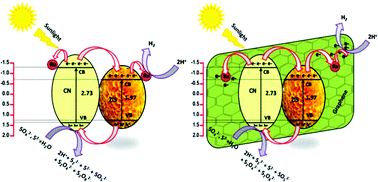当前位置:
X-MOL 学术
›
Photochem. Photobiol. Sci.
›
论文详情
Our official English website, www.x-mol.net, welcomes your
feedback! (Note: you will need to create a separate account there.)
Fabrication of a novel ZnIn2S4/g-C3N4/graphene ternary nanocomposite with enhanced charge separation for efficient photocatalytic H2 evolution under solar light illumination.
Photochemical & Photobiological Sciences ( IF 2.7 ) Pub Date : 2019-10-28 , DOI: 10.1039/c9pp00234k Saikumar Manchala 1 , V S R K Tandava 2 , Lakshmana Reddy Nagappagari 3 , Shankar Muthukonda Venkatakrishnan 3 , Deshetti Jampaiah 4 , Ylias M Sabri 4 , Suresh K Bhargava 4 , Vishnu Shanker 1
Photochemical & Photobiological Sciences ( IF 2.7 ) Pub Date : 2019-10-28 , DOI: 10.1039/c9pp00234k Saikumar Manchala 1 , V S R K Tandava 2 , Lakshmana Reddy Nagappagari 3 , Shankar Muthukonda Venkatakrishnan 3 , Deshetti Jampaiah 4 , Ylias M Sabri 4 , Suresh K Bhargava 4 , Vishnu Shanker 1
Affiliation

|
Design and synthesis of efficient photocatalyst systems for a large volume of hydrogen (H2) evolution under solar light is still a great challenge. To obtain high photocatalytic activity, graphene-based semiconductor photocatalysts are gaining heightened attention in the field of green and sustainable fuel production due to their good electronic properties, high surface area and chemical stability. Herein, we demonstrate an efficient, novel and smart architecture of a graphene-based ZnIn2S4/g-C3N4 nanojunction by a simple hydrothermal process for H2 generation. In the present study, graphene (G) is chosen as the electron mediator and ZnIn2S4 (ZIS) and g-C3N4 (CN) are chosen as two different semiconductor photocatalysts to construct a smart architecture for the ternary photocatalytic system. Different characterization techniques such as XRD, TGA, FT-IR, SEM, TEM, HR-TEM, XPS, BET, and UV-vis DRS were employed to ensure the successful integration of graphene, ZnIn2S4, and g-C3N4 in the nanocomposite. As a result, high and efficient H2 evolution (477 μmol h-1 g-1) is attained for the graphene-based ZnIn2S4/g-C3N4 nanocomposite. Transient photocurrent experiments, ESR, PL, and time-resolved PL studies suggested that the intimate ternary nanojunction effectively promotes fast charge transfer and thereby enhances photocatalytic H2 evolution.
中文翻译:

新型ZnIn2S4 / g-C3N4 /石墨烯三元纳米复合材料的制备,该复合材料具有增强的电荷分离能力,可在太阳光照射下有效地光催化分解H2。
对于在太阳光下大量析出氢气(H2)的高效光催化剂体系的设计和合成,仍然是一个巨大的挑战。为了获得高的光催化活性,基于石墨烯的半导体光催化剂由于其良好的电子性能,高表面积和化学稳定性而在绿色和可持续燃料生产领域中受到越来越多的关注。在这里,我们通过一个简单的水热过程来生成H2,展示了一种基于石墨烯的ZnIn2S4 / g-C3N4纳米结的高效,新颖和智能的体系结构。在本研究中,选择石墨烯(G)作为电子介体,并选择ZnIn2S4(ZIS)和g-C3N4(CN)作为两种不同的半导体光催化剂,以构建三元光催化系统的智能体系结构。不同的表征技术,例如XRD,TGA,FT-IR,SEM,TEM,HR-TEM,XPS,BET和UV-vis DRS用于确保石墨烯,ZnIn2S4和g-C3N4在纳米复合材料中成功整合。结果,对于基于石墨烯的ZnIn 2 S 4 / g-C 3 N 4纳米复合材料,获得了高效的H 2析出(477μmolh-1 g-1)。瞬态光电流实验,ESR,PL和时间分辨的PL研究表明,紧密的三元纳米结有效促进了电荷的快速转移,从而增强了光催化H2的释放。
更新日期:2020-01-01
中文翻译:

新型ZnIn2S4 / g-C3N4 /石墨烯三元纳米复合材料的制备,该复合材料具有增强的电荷分离能力,可在太阳光照射下有效地光催化分解H2。
对于在太阳光下大量析出氢气(H2)的高效光催化剂体系的设计和合成,仍然是一个巨大的挑战。为了获得高的光催化活性,基于石墨烯的半导体光催化剂由于其良好的电子性能,高表面积和化学稳定性而在绿色和可持续燃料生产领域中受到越来越多的关注。在这里,我们通过一个简单的水热过程来生成H2,展示了一种基于石墨烯的ZnIn2S4 / g-C3N4纳米结的高效,新颖和智能的体系结构。在本研究中,选择石墨烯(G)作为电子介体,并选择ZnIn2S4(ZIS)和g-C3N4(CN)作为两种不同的半导体光催化剂,以构建三元光催化系统的智能体系结构。不同的表征技术,例如XRD,TGA,FT-IR,SEM,TEM,HR-TEM,XPS,BET和UV-vis DRS用于确保石墨烯,ZnIn2S4和g-C3N4在纳米复合材料中成功整合。结果,对于基于石墨烯的ZnIn 2 S 4 / g-C 3 N 4纳米复合材料,获得了高效的H 2析出(477μmolh-1 g-1)。瞬态光电流实验,ESR,PL和时间分辨的PL研究表明,紧密的三元纳米结有效促进了电荷的快速转移,从而增强了光催化H2的释放。











































 京公网安备 11010802027423号
京公网安备 11010802027423号